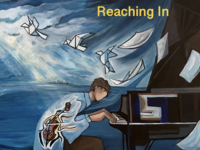Coming close on the heels of the passing of a historically great jazz composer and saxophonist, Henry Threadgill’s The Other One (PI Recordings) reminds us that there is a historically great jazz composer and saxophonist still in our midst.
Threadgill recently took on the ambition of creating a major, multimedia work involving two performances from a twelve-piece ensemble. Other parts of the presentation made in May 2022 at the Roulette Intermedium in Brooklyn included video, paintings, photographs, a pre-recorded choir made up of Threadgill’s own voices and even Threadgill singing while playing the piano. The first ensemble performance was titled “One” and the second one’s name reflecting Threadgill’s acute sense of humor, “The Other One.” That latter concert is what this record captures.
The Other One is a continuation of ideas Threadgill has put forth for a while, and it’s an entirely new direction; with him, both things can simultaneously be true. Threadgill’s primary composing playbook — imposing intervallic patterns while leaving room for group invention — remains in place. So are some of his recent band members such as David Virelles (piano), Christopher Hoffman (cello), Jose Davila (tuba) and Craig Weinrib (drums).
However, The Other One was conceived for a dozen musicians, and to these four he adds Alfredo Colón (alto saxophone), Noah Becker (alto saxophone, clarinet), Peyton Pleninger (tenor saxophone), Sara Caswell (violin), Stephanie Griffin (viola), Mariel Roberts (cello), Sara Schoenbeck (bassoon) and Adam Cordero (bassoon). Although the leader is a hell of a saxophone player, none of his playing is heard here as he’s got his hands full as the conductor.
“Of Valence – Movement I” begins with a section entirely played by only piano, putting Threadgill’s chart in an unusual setting in that there aren’t partners with which to bounce the song around and set it on an uncharted path. In its place is a pensive, reflective mood. Somehow, that serves as the right precursor to the third section, where the whole ensemble is introduced and demonstrating the absolute scalability of his songs.
Succeeding sections pull players in and out with great frequency, effectively making the ever-expanding and contracting orchestra work as a device Threadgill uses to effect the kind of impact he seeks to make. Virelles is a central figure through all this, as patterns are often introduced via his piano, helping to make sense of the string and horn sections playing competing harmonic components. Even when Weinrib gets an unaccompanied spot in Section 11, you can feel Threadgill’s guiding hand on the drum solo. The finale part of the first movement ends up sounding the closest to Zooid, even with non-Zooid instruments doing the improvising because the music itself is the personality that outshines even the musicians who play it.
“Movement II” is presented as a single, sixteen-minute section. From humble, string-led beginnings, the swell builds and gradually turns into an episodic conversation between strings and alto sax. The unusually human way the string trio of Caswell, Griffin and Roberts performs results from them playing their parts while their pre-recorded heartbeats were played back to them. Threadgill used this novel approach to engender more spontaneity as they execute his elaborate sketches, and it worked.
Like the first movement, the third and final movement is further broken up into many sections. Section 12 particularly resembles Threadgill’s small ensemble music, which makes the string section so fascinating to hear since we’re not used to hearing a string trio play music constructed in this way. Section 14 also carries a ‘Make A Move’ vibe but with Threadgill as arranger and conductor taking advantage of the additional resources at his disposal to bring more harmonic shards out of his melody.
Closely coinciding with the release of his memoirs Easily Slip Into Another World: A Life in Music, the seventy-nine year old Henry Threadgill signaled his intent to write more chapters with the sweeping multimedia project that birthed The Other One. By expanding his band into an orchestra, Threadgill demonstrated that his deviceful musical ideas are not only scalable, but eminently enduring.
Pre-order/order The Other One from Bandcamp.
- Ches Smith Quartet – ‘Clone Row’ (2025) - May 30, 2025
- James Brandon Lewis Quartet – ‘Abstraction Is Deliverance’ (2025) - May 27, 2025
- Soft Machine – ‘Drop’ (1971, 2025 remaster) - May 21, 2025



